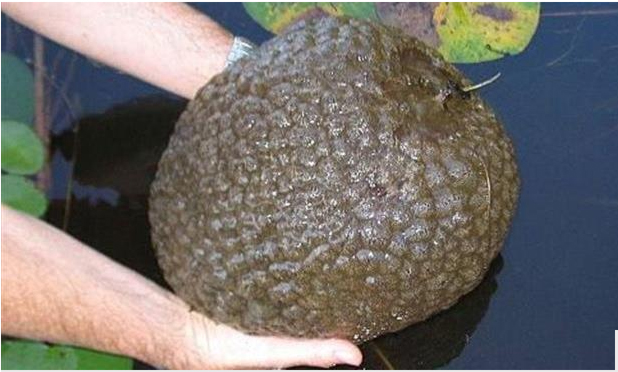It looks like you're using an Ad Blocker.
Please white-list or disable AboveTopSecret.com in your ad-blocking tool.
Thank you.
Some features of ATS will be disabled while you continue to use an ad-blocker.
12
share:
'Dragon Booger' Emerges From Lost Lagoon

I'd love to find one. Creepy cool.
Maybe it's just no one ever noticed them before?
peace

Pectinatella magnifica, a water-dwelling blob, has long confounded scientists trying simply to categorize them. The brown-green snotty lumps are called bryozoans, and sometimes "moss animals," "dragon boogers," and "ectoprocta," which means, "anus outside," reports Popular Science. The blobs, which are actually whole colonies of tiny organisms, look most like polyps or coral, but they're probably more closely related to mollusks. And now, they've been unearthed in a biofiltration pond near Stanley Park's Lost Lagoon in Vancouver, reports the Vancouver Courier.
I'd love to find one. Creepy cool.
The discovery is notable because bryozoan clumps have typically been found only east of the Mississippi. Scientists are currently debating whether they are invasive and whether a warming climate is helping them spread, reports National Geographic. They filter nutrients from algae, so there's a chance they harmfully alter freshwater ecology—and they can clog pipes. On the flip side, their presence suggests good water quality, reports Gizmodo.
Maybe it's just no one ever noticed them before?
peace
edit on 5327Tuesday201713 by silo13 because: vid
Uh , oh. Horror movies start out with someone handling something or poking it with a stick . Good things never come from this...
Heard about this, it's local in Vancouvers Stanley Park..creepy.
Good thing I bought my nuclear gas mask respirator today. Just looking at that, it looks like it smells. Watch some dingbat, try and eat it and claim
its an aphrodisiac. Than it will be worth millions.
edit on 5-9-2017 by Diabolical1972 because: (no reason given)
At first I thought it was a breadfruit or something, geez thats gross
I see that they are trying to connect the story with global warming.
Not surprised at that.
Not surprised at that.
First thing I thought of was the movie Slither...
*shudders* there is one area for me to avoid in the future, yuck.
*shudders* there is one area for me to avoid in the future, yuck.
I just get the feeling it's a very, very, very bad idea to keep one of those in your house at night ... People will start disappearing and then
reappearing...
new topics
-
How the Sikhs Deal with Muslim Grooming Gangs – Tommy Robinson
Social Issues and Civil Unrest: 1 hours ago -
Paranoid Liberals Believe U.S. Service Members are More Dangerous than Illegal Aliens.
Social Issues and Civil Unrest: 2 hours ago -
The 119th Congress has Officially Opened for Business
Mainstream News: 3 hours ago -
Here we again... CHINA having mass outbreak of something
Diseases and Pandemics: 3 hours ago -
Flee from idolatry
Religion, Faith, And Theology: 8 hours ago -
FIEND SLASHED: Sara Sharif’s killer dad ‘has neck & face sliced open with jagged tuna tin lid
Mainstream News: 8 hours ago -
Musk calls on King Charles III to dissolve Parliament over Oldham sex grooming gangs
Mainstream News: 9 hours ago -
Grenfell Tower Fire revisited
Mainstream News: 10 hours ago -
The Why Files Lacerta Reveals the Truth of our Creation
Aliens and UFOs: 11 hours ago
top topics
-
Musk calls on King Charles III to dissolve Parliament over Oldham sex grooming gangs
Mainstream News: 9 hours ago, 14 flags -
The Why Files Lacerta Reveals the Truth of our Creation
Aliens and UFOs: 11 hours ago, 11 flags -
Grenfell Tower Fire revisited
Mainstream News: 10 hours ago, 9 flags -
FIEND SLASHED: Sara Sharif’s killer dad ‘has neck & face sliced open with jagged tuna tin lid
Mainstream News: 8 hours ago, 9 flags -
The 119th Congress has Officially Opened for Business
Mainstream News: 3 hours ago, 6 flags -
Here we again... CHINA having mass outbreak of something
Diseases and Pandemics: 3 hours ago, 5 flags -
Paranoid Liberals Believe U.S. Service Members are More Dangerous than Illegal Aliens.
Social Issues and Civil Unrest: 2 hours ago, 4 flags -
Flee from idolatry
Religion, Faith, And Theology: 8 hours ago, 3 flags -
How the Sikhs Deal with Muslim Grooming Gangs – Tommy Robinson
Social Issues and Civil Unrest: 1 hours ago, 2 flags
active topics
-
Tesla Cybertruck Explodes in Front of Trump Hotel in Las Vegas
Mainstream News • 171 • : CarlLaFong -
Ukraine halts transit of Russian gas to Europe after a prewar deal expired
Political Conspiracies • 141 • : Oldcarpy2 -
The Why Files Lacerta Reveals the Truth of our Creation
Aliens and UFOs • 7 • : ARM19688 -
The 119th Congress has Officially Opened for Business
Mainstream News • 16 • : xuenchen -
Elon Musk Calls for Tommy Robinson to be Freed - and Takes a Dig at Starmer
Politicians & People • 15 • : BedevereTheWise -
Grenfell Tower Fire revisited
Mainstream News • 7 • : BeyondKnowledge3 -
How the Sikhs Deal with Muslim Grooming Gangs – Tommy Robinson
Social Issues and Civil Unrest • 3 • : Freeborn -
Paranoid Liberals Believe U.S. Service Members are More Dangerous than Illegal Aliens.
Social Issues and Civil Unrest • 17 • : BeyondKnowledge3 -
Something is not adding up in regards to the H-1B commotion
General Conspiracies • 29 • : namehere -
-@TH3WH17ERABB17- -Q- ---TIME TO SHOW THE WORLD--- -Part- --44--
Dissecting Disinformation • 3915 • : Thoughtful3
12
